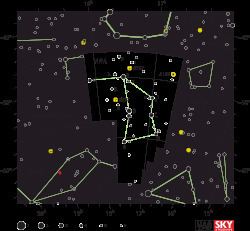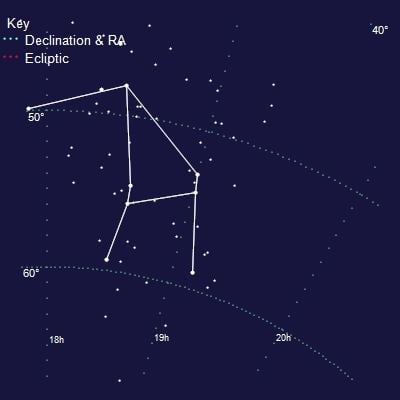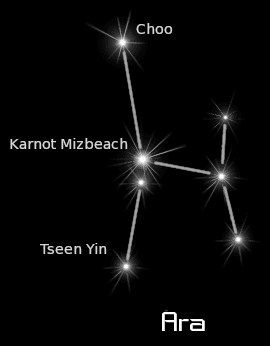Abbreviation Ara Symbolism the Altar Main stars 8 Messier object 0 | Genitive Arae Name The Altar Bayer/Flamsteed designation 17 | |
Pronunciation /ˈɛərə/, genitive /ˈɛəriː/ Right ascension 16 34 16.9497–18 10 41.3407 Declination −45.4859734°–−67.6905823° Bordering constellations Similar | ||
Ara (Latin: "The Altar") is a southern constellation situated between Scorpius and Triangulum Australe. Ara (Greek: Βωμός) was one of the 48 Greek constellations described by the 2nd century astronomer Ptolemy, and it remains one of the 88 modern constellations defined by the International Astronomical Union.
Contents
- History
- Equivalents
- Characteristics
- Stars
- Deep sky objects
- Open clusters
- Globular clusters
- Planetary Nebulae
- Namesakes
- References

The orange supergiant Beta Arae is the brightest star in the constellation, with an apparent magnitude of 2.85—marginally brighter than the blue-white Alpha Arae. Seven star systems host planets. The sunlike star Mu Arae hosts four planets, while Gliese 676 is a binary red dwarf system with four planets. The Milky Way crosses the northwestern part of Ara.

History

In ancient Greek mythology, Ara was identified as the altar where the gods first made offerings and formed an alliance before defeating the Titans. The nearby Milky Way represents the smoke rising from the offerings on the altar,

Ara is one of the southernmost constellations depicted by Ptolemy. It had been recorded by Aratus in 270 BCE as lying close to the horizon, and the Almagest portrays stars as far south as Gamma Arae. Professor of astronomy Bradley Schaefer has proposed that ancient observers must have been able to see as far south as Zeta Arae to define a pattern that looked like an altar.
In illustrations, Ara is usually depicted as an altar with its smoke 'rising' southward. However, depictions of Ara often vary in their details. In the early days of printing, a 1482 woodcut of Gaius Julius Hyginus's classic Poeticon Astronomicon depicts the altar as surrounded by demons. Johann Bayer in 1603 depicted Ara as an altar with burning incense; the flames rise southward as in most atlases. Hyginus also depicted Ara as an altar with burning incense, though his Ara featured devils on either side of the flames. However, Willem Blaeu, a Dutch uranographer active in the 16th and 17th centuries, drew Ara as an altar designed for sacrifice, with a burning animal offering. Unlike most depictions, the smoke from Blaeu's Ara rises northward, represented by Alpha Arae. A more unusual depiction of Ara comes from Aratus, a Greek uranographer, in 270 BCE. He drew Ara as a lighthouse, where Alpha, Beta, Epsilon, and Zeta Arae represent the base, and Eta Arae represents the flames at the lighthouse's light.
Equivalents
In Chinese astronomy, the stars of the constellation Ara lie within The Azure Dragon of the East (東方青龍, Dōng Fāng Qīng Lóng). Five stars of Ara formed Guī (龜), a tortoise, while another three formed Chǔ (杵), a pestle.
Characteristics
Covering 237.1 square degrees and hence 0.575% of the sky, Ara ranks 63rd of the 88 modern constellations by area. Its position in the Southern Celestial Hemisphere means that the whole constellation is visible to observers south of 22°N. Scorpius runs along the length of its northern border, while Norma and Triangulum Australe line it to the west, Apus to the south, and Pavo and Telescopium to the east respectively. The three-letter abbreviation for the constellation, as adopted by the International Astronomical Union, is Ara. The official constellation boundaries, as set by Belgian astronomer Eugène Delporte in 1930, are defined by a polygon of twelve segments. In the equatorial coordinate system, the right ascension coordinates of these borders lie between 16h 36.1m and 18h 10.4m, while the declination coordinates are between −45.49° and −67.69°.
Stars
Bayer gave eight stars Bayer designations, labelling them Alpha through to Theta, though he had never seen the constellation directly as it never rises above the horizon in Germany. After charting the southern constellations, Lacaille recharted the stars of Ara from Alpha though to Sigma, including three pairs of stars next to each other as Epsilon, Kappa and Nu.
Ara contains part of the Milky Way to the south of Scorpius and thus has rich star fields. Within the constellation's borders, there are 71 stars brighter than or equal to apparent magnitude 6.5.
Just shading Alpha Arae, Beta Arae is the brightest star in the constellation. It is an orange-hued star of spectral type K3Ib-IIa that has been classified as a supergiant or bright giant, that is around 650 light-years from Earth. It is around 8.21 times as massive and 5,636 times as luminous as the Sun. At apparent magnitude 2.85, this difference in brightness between the two is undetectable by the unaided eye.
Alpha Arae is a blue-white main sequence star of magnitude 2.95, that is 270 ± 20 light-years from Earth. This star is around 9.6 times as massive as the Sun, and has an average of 4.5 times its radius. It is 5,800 times as luminous as the Sun, its energy emitted from its outer envelope at an effective temperature of 18,044 K. A Be star, Alpha Arae is surrounded by a dense equatorial disk of material in Keplerian (rather than uniform) rotation. The star is losing mass by a polar stellar wind with a terminal velocity of approximately 1,000 km/s.
At magnitude 3.13 is Zeta Arae, an orange giant of spectral type K3III that is located 490 ± 10 light-years from Earth. Around 7–8 times as massive as the Sun, it has swollen to a diameter around 114 times that of the Sun and is 3800 times as luminous.
Close to Beta Arae is Gamma Arae, a blue-hued supergiant of spectral type B1Ib. Of apparent magnitude 3.3, it is 1110 ± 60 light-years from Earth. It has been estimated to be between 12.5 and 25 times as massive as the Sun, and have around 120,000 times its luminosity.
Delta Arae is a blue-white main sequence star of spectral type B8Vn and magnitude 3.6, 198 ± 4 light-years from Earth. It is around 3.56 times as massive as the Sun.
Exoplanets have been discovered in seven star systems in the constellation. Mu Arae is a sunlike star that hosts four planets. HD 152079 is a sunlike star with a planet. HD 154672 is an ageing sunlike star with a Hot Jupiter. HD 154857 is a sunlike star with one confirmed and one suspected planet. HD 156411 is a star hotter and larger than the sun with a gas giant planet in orbit. Gliese 674 is a nearby red dwarf star with a planet. Gliese 676 is a binary star system composed of two red dwarves with four planets.
Deep-sky objects
The northwest corner of Ara is crossed by the galactic plane of the Milky Way and contains several open clusters (notably NGC 6200) and diffuse nebulae (including the bright cluster/nebula pair NGC 6188 and NGC 6193). The brightest of the globular clusters, sixth magnitude NGC 6397, lies at a distance of just 6,500 light-years (6.1×1016 km), making it one of the closest globular clusters to the Solar System.
Ara also contains Westerlund 1, a super star cluster that contains the red supergiant Westerlund 1-26, one of the largest stars known.
Although Ara lies close to the heart of the Milky Way, two spiral galaxies (NGC 6215 and NGC 6221) are visible near star Eta Arae.
Open clusters
Globular clusters
Planetary Nebulae
Namesakes
USS Ara (AK-136) was a United States Navy Crater class cargo ship named after the constellation.
